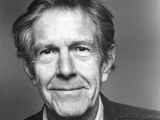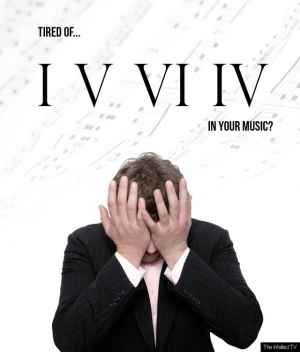The Popular Music Dilemma: What John Cage Can Teach Us about Listening

The Popular Music Dilemma
We often hear popular music spoken of with disdain. We accuse rappers of promoting poor values and condemn pop stars for being too provocative. While those types of arguments often have plenty of merit, it is important to consider the other side of things as well. We need to remember that popular music is a business. Producers think of their music as a product, and seek to form it into something easy to digest and immediately entertaining for the listener. Other types of music, the kind composed by artists who are more likely to be intrinsically motivated, require much more work on the part of the listener. The marketability of the former pushes other genres out of the limelight, listeners hear and anticipate a certain type of “sound” after a while, and the cycle continues.
Anyone seeking to enjoy contemporary or post modern music will have to forego popular music streaming services like Spotify and Pandora and search for hours for the kind of music they like, all while cultivating their musical ears to a degree that allows them to be comfortable with non-traditional sounds. It is my hope that after reading this article, you will have a fresh perspective to give the next time your friend or family member, caught up in the nostalgia of the 60’s says, “music these days just isn’t good anymore”. Maybe the type of music that becomes popular says something about us. If that is true, maybe there is also something we can do about it.
One reason we worry about the content in music is that art is in some ways viewed as an educational tool. When songs like “Take me to Church” play on the radio, we hail them as progressive because they promote social change. When songs promote violence or drugs, we condemn them for advertising poor values, which can lead us to the opinion that artists should stop writing music like that. It is also important to realize that imposing restrictions on the content of music is somewhat like telling fast food chains their french fries can only have a certain amount of calories. Maybe the problem really lies in the fact that we like french fries way too much. We will play songs on the radio over and over until our ears are weighted down by the redundancy and even our favorite songs have lost their luster. Technology has brought us to the point where we can instantly gratify our cravings with almost anything we want, and we are beginning to realize that this might not be so healthy for us. No easy answer presents itself when we look at what responsibility companies or music labels have in promoting social change. However, when we look at what responsibility consumers have in this arena, some practical options arise.
One option is to shift our focus away from being consumers towards being more adventurous in our exploration of sound. Social messages are only one small part of what makes something art. There are contemporary composers out there right now writing music that is high quality, but it is not advertised and honestly is hardly even recognized as art by many music lovers. These composers use radical techniques like atonal melodies, nontraditional instruments, and complicated rhythms in their music. While there has been a disappointing divide between popular music and contemporary classical music in the past years, these two sides can come together beautifully and there are ways that we can continue this trend in the future.
Building Bridges

You can hear hints of these techniques in the soundtracks of the Lord of the Rings where Howard Shore brings the melancholic dissonance of Arvo Part to the big screen, Lost where Michael Giacchino creates an ensemble of great sounds using PROPS FROM THE PLANE CRASH SCENE (sorry for yelling, I’m still geeking out about that), and Sherlock Holmes (Robert Downey Jr’s film) where Hanz Zimmer uses an invention he discovered on YouTube called the “Experibass”. In fact, most of the music you hear in films draws from contemporary music. The Star Wars soundtrack was not composed out of the blue. John Williams relied heavily on The Planets by Gustav Holst for inspiration.
Sadly, anything relying too heavily on contemporary (often atonal) methods is deemed only fit for horror or drama like the scores in The Shining (Wendy Carlos, and Rachel Elkind-Tourre) or There Will be Blood (Jonny Greenwood, guitarist from Radiohead), in part because the uncertain or uncomfortable reaction these sounds elicit from most people complement the style. As an interesting side note, the main theme of The Shining soundtrack uses a motif from Berlioz’s Symphonie Fantastique, yet another example of classical music influencing popular music. It might not be appropriate for me to label soundtracks as popular music because, as I have shown, in many cases the lines are fairly blurred. These bridges between contemporary and popular music are rare because the two areas have become sadly polarized in recent years. Many people who listen to well-known contemporary pieces such as “Pierrot Lunaire” by Arnold Schoenberg, or Schubert’s “Der Erlkonig”, are somewhat put-off, and because of this fail to pursue further contemporary classical music.
Much of the contemporary classical music world is difficult to listen to, and the absence of an emotional connection to foreign sounding music leaves listeners with lingering discomfort. Music lovers want to listen to something that sounds “good”. “Good” music is supposed to immediately inspire us with feelings like triumph or sadness. This is the popular view, at least. When we hear something that makes no sense at all, we assume there is no sense of which to make. The expectation is that music should immediately entertain, as if it is some sort of product. However, before we can really tell if it resonates with us, we first need to make sure we are listening correctly. We can think of this as being a radio stuck at one station, versus a radio with a working dial. Once we know how to adjust our ears, we can “tune into” different styles that are just as enjoyable as popular styles.
John Cage
John Cage, a famous American composer, has a lot to say about how we listen to music. Throughout his career, he experimented with non-traditional styles such as chance, indeterminacy, and unusual instruments. Eastern thought and philosophy heavily influenced his avant-garde musical style. He composed 4’ 33”, his most famous piece, just before the peak of his career in 1952 . John Cage explains his philosophy behind 4’33” seconds here. For those of you who are not familiar with the piece, it is originally for piano but it can be performed by many different ensembles (which, for those of you who have listened to the piece, is not quite as irrelevant as you might think). It is always exactly 4 minutes and 33 seconds as the title implies. For the purposes of this discussion, deciding whether this technically counts as music or not is pointless. What we need to look at is how this makes us think about what music means to us and how that relates to what we hear in popular music.
Like working ourselves up towards reading difficult books, we have to work towards being able to understand and enjoy more complicated music. Just like exercising or eating better, the onset can be the opposite of rewarding but the long term benefits are worth the work.

Listening to 4’ 33” can be quite baffling at first. The performers sit motionless as the conductor keeps time with almost mock seriousness. Coming from a stereotypical perspective of music, the entire piece seems ridiculous. This is because we assume that what we should be listening to is the sound given to us by the performer. Yes, this is one way we can listen to music, but it is not the only way. Audience members in those performances who really keep an open mind during this piece might start to become hyper aware of the sounds around them. Lights buzzing, seats creaking, confused whispering, and air conditioners humming are all sounds that are ignored normally, but can come together in a beautiful way. Listeners realize that they are not listening to silence at all. Cage’s piece is hailed as revolutionary, not for its aesthetic value, but in its ability to challenge current perspectives of music. If we could treat all sound with this much respect, we could find as much beauty in the sounds of a busy street corner as we could in our favorite pop song.

The Four Chord Song
Relinquishing preconceived notions of how things should be allows us to savor what simply is. What happens when we don’t do this? Holding onto expectations of quality condenses and limits the potential sound available for us to hear. We crave originality but demand familiarity. Basically, we want to have our cake and eat it too. Popular music has identified and maximized on what could be considered the most popular way of writing music; the notorious “four chord song”. The problem with this lies in the fact that there are only so many ways to write a song with four chords. If you haven’t already, take a listen to the YouTube video by the Axis of Awesome (warning, the f-bomb is dropped). They compile a chain of famous choruses in succession without changing the key, tempo, or chord progression. What this is intended to show is just how many different songs, even our cherished classics, use the very same techniques. With these limitations set in place by the demanding audience, it’s no wonder we can’t be satisfied!
What Happens Next?
John Cage would encourage listeners to withhold immediate judgement when listening to music. Sometimes it takes a few listens to get into an album. That is when you know your mind has found brilliance. When the complexity is just too much to make sense of, or the meaning to deep to grasp during the first listen. Try this right now with a piece by SO Percussion. Remember, the point is to listen with an open mind.
The “fault” of a “declining” music industry lies nowhere in particular. Artists bear as much responsibility for creating originality as we have in putting forth effort to interpret it. It is important to note that songs on the radio are not inherently worse than any other type of music. Who hasn’t jammed out to Katy Perry at least once? Something about four chord songs seems to immediately hit us with a direct and intense sensation. How else could songs we don’t even really like get stuck in our heads? This is no better or worse than savoring a cheeseburger or enjoying our favorite reality TV show. The state of the music industry today shows us just what can happen when we have too much of a good thing. With our busy schedules and hectic lives, it is just as difficult to take the time to learn about contemporary classical music as it is to maintain a healthy diet. It takes time, energy, and sometimes even outside guidance.
However, if music is really important to you, instead of complaining about how bad music is these days, listen to a contemporary song you haven’t heard before. Consider it auditory calisthenics. Start off with a an earlier piece like Igor Stravinsky’s The Rite of Spring, then move towards more modern challenges to classical styles like “The Unanswered Question” by Charles Ives, until you get to the postmodern period with composers like John Adams (start with “Shaker Loops”). You probably won’t like everything you hear but neither do the pros! Make a commitment to listen to just one piece each day, and your musical world will expand wonderfully. Dear readers, I leave you with a quote (falsely attributed to Nietzsche) that says, “those who were seen dancing were thought to be insane by those who could not hear the music.”
What do you think? Leave a comment.











An intriguing read. Although John Cage is not exactly my taste, it is nice to know there are people experimenting with music in comparison to the tripe which is usually popular.
John Cage was a good provocateur, in the purest tradition of the avant-garde.
I was lucky enough to see the John Cage exhibition at Kettle’s Yard in Cambridge a couple of years back and came away a reinvigorated artist with my eyes open wide again.
4′-33 is not about silence, but listening.
I’ve recently re-listened to his Prepared Piano stuff in the early morning, and really enjoyed it: not difficult to take in at all.
wonderful musician and artist. unforgettable songs, inspiration and moments. great article
He changed how I listen to music, for the better.
In 50 years time no one on the planet will listen to Cage.
I always thought of it as being a bit like John Berger’s seminal book ‘On Seeing’, it invites us to hear everything around us. It is in fact the ultimate portable piece. For example, its the one you can take up to the top of mountain to enjoy with a wonderful view – without an MP3 player – fabulous.
While we might not listen to Cage’s music in 50 years, it is a fact that since the ’80s we increasingly have been listening to music under Cage’s influence. Directly and indirectly, his writings in “Silence” and his music altered the notion of music from thousands of bands, electronic music producers and dancers. One might not had read Newton, but still aware of the apple-story. Cage has the same significance for music.
That is an hilarious comment.
That is quite assuredly, untrue.
https://www.mysanantonio.com/entertainment/article/Slow-music-Chord-change-in-Germany-of-639-year-15545235.php
I heard – is it true? – that John Cage was not very good at composing melodies.
Cage contributed more than most thinkers.
Great article!
Cage was the great liberator for musicians trained in the tradition of western music, because he saw more clearly than anyone else that a score was not a sacred text but a an infinitely adaptable set of instructions.
The trouble is people usually believe what they’re told by composers. It’s all part of the great mystery where composers commune with God or whatever and invent from scratch these masterpieces that contain every nuance of the emotional responses we have to them within the dots and lines.
4’33” is the classic example of the folly of taking the composer’s word: we’re supposed to believe that the point of the piece is to listen to the sounds around us. That’s nonsense.
I love the string quartet and the pieces for prepared piano, in particular.
The ‘point’ of 4′ 33″, if Cage could ever have been bothered to invent one for it, is that the audience hears what’s happening inside and outside the piano, not least, in its Woodstock NY premiere, the thunderstorm that accompanied it.
Thank you, very thoughtful article.
This is a great piece on an artist I’ve genuinely never heard of. I’ll have to give him a listen!
excellent article, it really distills a lot of ideas i couldn’t quite form, and Jon Cage is superb. He changed the way i hear the world.
What Cage taught me more than anything else was the content of silence in music. Just as we tend to think that the meaning of poetry is in the black marks on the page rather than the white spaces between, so we tend to think that music happens in the performance of the black marks on the page. Both the blank spaces on the page and the rests in music are to me like characters on a stage who are not engaged in dialogue: when you read the script, they’re virtually not there; when you see them on the stage, their very silence is meaningful. Cage forces us to think of silence as more than the absence of sound in music.
I just want to warn you against using the phrase “listening correctly.” As soon as we start telling people how they are meant to hear something, we’re creating an impenetrable barrier around music. That being said, there is some music that is indeed more easily accessible. John Williams knew this well, and that’s why he has had such a longstanding collaboration with Steven Spielberg. He creates attractive, Romantic, lush orchestral, and thoroughly Western music because that is the demographic they aim to please. That’s business and that’s Hollywood.
Composers such as John Cage are fantastic in that they are trying to stretch our understanding of “good” music beyond Western tonality and timbres. As much as I love to see this happening, the population isn’t going to change overnight. Just like gender roles, language and other marks of culture, Western music is ingrained in us from infancy. Each time we sing “happy birthday,” stand for the national anthem, and even step onto the subway, we hear snippets of melodies with the same I-IV-V-I chord progression. When Spielberg introduces aliens in Close Encounters of the Third Kind, Williams appropriately makes the music “alien” by using instrumentation atypical of a classical orchestra, but even then not venturing too far out of the comfort zone of a Hollywood audience. Unfortunately, eclectic/ atonal music will only interest a small population of enthusiast, but as long as it continues to delight and amuse, I say play on!
I couldn’t agree more! Yes, we have to be careful not to impose our own mode of experience on others. That’s why I tried to portray the “correct” way of listening as an openness to experience, and nothing more than that. This way we can enjoy pop and contemporary music equally, with the added benefit of expanding our horizon of experience!
Cage is chill.
Enjoyed your piece. Very important content for all people. I am a contemporary saxophone player, with a special interest in collaborative performance projects with artists of different disciplines of performing arts. Lots of critical and reflective thinking involved in performing art projects. Are you aware of John Cage’s compositional techniques? Some of his best works are composed using ‘chance’, through a Chinese classic text which describes a symbol system used to identify order in chance events called the I Ching. Would love to chat about potentially finding a topic for a joint article.
Cheers!
Simon MacLeod
Bachelor of Music Performance
University of Calgary
I can be very focused in what I do and how I experience the world. Someone once said I am so intense, I’m like a laser beam. When I listen to music, nothing else in the world exists in that moment for me.
When I first listened to John Cage, I had an immediate “I don’t like it” reaction. Then I read some of his written work and believe I developed an understanding of what he may be trying to convey; as this article superbly did.
I brought a cd player outside and listened to one of his pieces (I believe it was ‘Cartridge Music’) with the volume at a moderate level. As I listened, I consciously “added” the ambient sounds around me as part of the John Cage piece. My world expanded, as it was no longer “Me + Music”, but “Me + All Sound”. A new way to listen to music. A new way to experience the world. John Cage expanded my choices on how to be.
The music industry is no different than that of the toilet paper industry. Though the t.p. industry actually provides more of a service to humanity.
The L.C.D.’s and formulas of it’s core are revamped over & over to feed the pavlov dog consciousness of society. Simply due to avarcie and fear based ignorance.
Industry, doesn’t work to provide choice or provoke people to think or aspire beyond they pre-ordained boundaries. It’s objective is to maximise profits and keep the jack-ass mule bound to it’s master.
This is mass pop culture.
The culture is: Secure profits & predict what the audience should listen to. Contrive what has already been contrived, be that in attitude, slogan or garb.
The plight is so engrained into society that diversity is often discomforting for the masses. The ant hill must be maintained by the workers. The workers are the slaves who keep the conveyor belt running and the dork CEOs still eating foie gras.
The web of unconsciousness is so thickly woven via an ear-worm that only a catastrophic event or shock therapy could divert its continuance. The goal, is profit. Even if it be cloaked with new age “save the world” sugar coating.
Pop media is a conveyor belt drewling with inane electromagnetic dribble that drills into the amygdala numbing it’s children into slave mentality dressed in what is defined as “cool”.
Thus, the reason for audio called “music” that is filled with airline commercial verse chorus 4/4 mold feces and usage of words like “awesome”.
When I learned about Cage’s 4’33” in my music history class and watched him perform his piece, “Water Walk” (music produced by household items), I was intrigued by his philosophy. He was trying to express that everything you hear around you is considered music, including silence. It really opened my mind.
What a lovely piece of writing. I’d only add that some modern/ contemporary music is actually pretty easy to listen to, and could perhaps function as a springboard for the adventurous listener. Before the Webern, try Alban Berg or some of Shoenberg’s gorgeous music composed for voice. Early Philip Glass (Glassworks, Einstein on the Beach) and Steve Reich offer an expansive listening experience in an accessible package. Also, i think many recordings by Kronos Quartet are very good contemporary music primers. Finally, if you ever have a chance to hear Cage’s music performed live, don’t miss it.